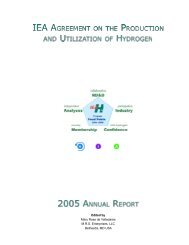Technology Status of Hydrogen Road Vehicles
Technology Status of Hydrogen Road Vehicles
Technology Status of Hydrogen Road Vehicles
Create successful ePaper yourself
Turn your PDF publications into a flip-book with our unique Google optimized e-Paper software.
Fischer and Eichert (1995) provide an updated critical review <strong>of</strong> the data (mostly experimental) that affect the<br />
behavior <strong>of</strong> hydrogen in situations relevant to safety. Though general, this review repeatedly illustrates how<br />
the behavior can be greatly affected by the initial and boundary conditions, i.e., the specifics <strong>of</strong> each accident.<br />
Fischer et al. (1996) state that today modeling and simulation show good agreement with a variety <strong>of</strong> fast<br />
combustion phenomena observed in experiments. One useful result would be the design <strong>of</strong> improved<br />
detonation arrester geometries. Sanai (1996) proposes an accident analysis algorithm, based on available<br />
experimental data and computer simulation <strong>of</strong> explosion accidents, to quickly calculate the response <strong>of</strong> humans<br />
and structures to such accidents. Maas (1996) handles phenomena such as auto ignition, induced ignition,<br />
minimum ignition energy, the transition from deflagration to detonation, and catalytic combustion, and<br />
concludes that the rapid improvements in numerical simulation and computing power will soon allow good<br />
simulation <strong>of</strong> practical combustion systems with complex geometry. Kratzel (1996) also models the processes<br />
leading to detonation, especially in complex geometries, among the most challenging to hydrogen safety.<br />
Table 3 is a selection <strong>of</strong> parameters from Fischer and Eichert (1995) and Kalyanam and Moore (1987).<br />
Table 3. Safety-Related Properties <strong>of</strong> <strong>Hydrogen</strong> and Conventional Fuels<br />
Property Unit H 2 CH 4 Gasoline Diesel<br />
Gas density g/l NTP 0.08 0.65 4.4 -<br />
Lower heating value kWs/g 120 50 44 43<br />
Stoichiometric composition in air vol. % 29.5 9.48 1.75 -<br />
Buoyant velocity in air m/s >1-0 >1-6 nonbuoyant nonbuoyant<br />
Self-ignition temperature °C 585 540 230-470 251<br />
Flame temperature in air °C 2045 1875 2200<br />
Ignition limits in air vol. % 4-75 5-15 1->7 7<br />
Minimum ignition energy mWs 0.02 0.29 0.24 -<br />
Flame speed in air cm/s -295 -41 -40 -<br />
Flame thermal radiation % 17-25 23-33 30-42 -<br />
Maximum safe gap in air mm 0.08 1.2 0.7 -<br />
Detonation limits in air vol. % 18-59 >6->13 >1->3<br />
Detonation velocity in air km/s -1.8 -1.5 -1.6 -<br />
Theoretical explosive yield per m 3 kg TNT 2.02 7.03 44.22 -<br />
It is not advisable to rate the above properties according to their importance to safety. Many authors focus<br />
on the ease <strong>of</strong> ignition (limits and minimum energy for ignition), the speed <strong>of</strong> combustion, the potential for<br />
detonation, and so on, as <strong>of</strong> particular concern. But closer examination can easily re-dimension the apparent<br />
gravity <strong>of</strong> these factors:<br />
! The lower ignition limit guides the evolution <strong>of</strong> most fires, and there is little difference between the<br />
various fuels; in fact, propane has the lowest limit.<br />
26













